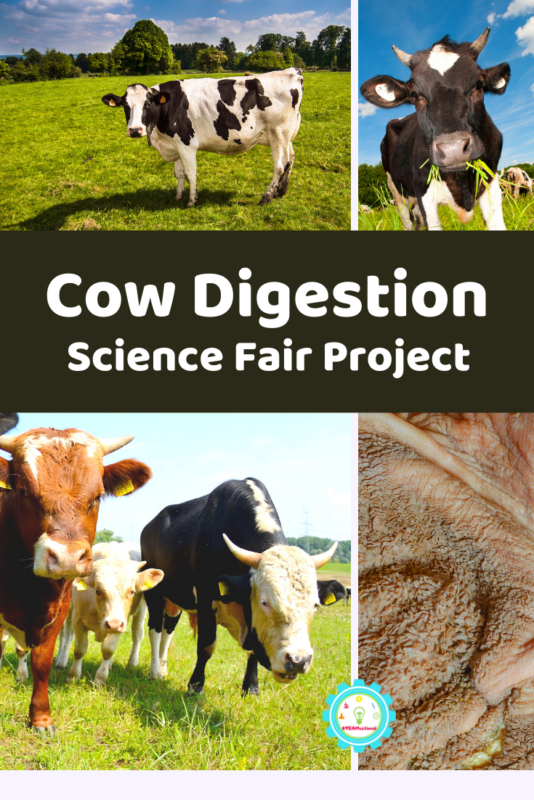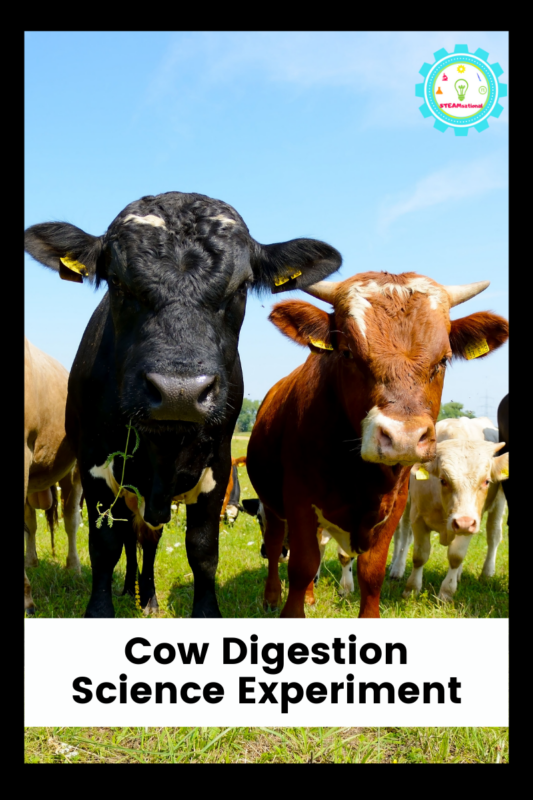Every great science fair project starts with a question.
Today’s question is “how does a cow’s digestive system work?” In this cow digestive system project kids will create a fun and hands-on science project that answers this question and would be perfect for any school science fair.
While doing this science project, kids learn all about the four chambers of a cow’s heart, why cows can eat grass, why humans can’t, and all of the basic parts that a cow uses to digest grass and the other foods it eats.
This specific science lesson on bovine digestion is a fun addition to elementary school science fair projects.

Easy Cow Digestive System Project Perfect for an Elementary Science Fair!
The science fair can be a stressful time, but with this fun, easy project elementary kids can have fun with the science fair instead of feeling like they hate science! Learn how to do the cow digestive system project below and get everything you need to complete this easy science fair project! It is a fun addition to classic science fair projects.
How Does a Cow’s Digestive System Work?
Digestion in ruminants (cows and sheep and many other animals who eat grass are ruminators) is similar to human digestion, but there are key differences. Ruminant stomachs have four
compartments, which helps ruminants digest plant material much more efficiently than humans.
Ruminants also chew their cud, which means that food is broght up from a stomach compartment and chewed again to breakit down further.
The four chambers of a cow’s stomach are:
- Rumen: Largest stomach that breaks food down with microbes to make it easier to digest. When grass is fermented, it is brought back to the mouth to be chewed again.
- Reticulum: This is a protective area of the stomach that prevents things that a cow shouldn’t eat from moving into other parts of the stomach, like heavy or dense items (some farmers will find metal in this stomach)
- Omasum: When the chewed cud returns to the stomach, it passes through the omasum which pulls moisture and nutrients from the grass.
- Abomasum: This is the last chamber of the stomach and it is the most similar to a human stomach where it breaks down food into usable nutrients.
Cow Digestive System Facts
Research is an important part of science and science fairs. Kids should look at books about cow anatomy and how each part of their bodies is different or the same as a human body.
I’ve created a mini worksheet packet that can help students identify the main biological processes going on in a cow’s digestive tract and using that information, a student can form their hypothesis and variables to test in their science fair project.
Download the cow digestion research documents and read the study guide together then complete the worksheet.
Use this study as a jumping off point to learn more about cows and other farm animals. This detailed article from Mississippi State University has detailed info on how a cow’s digestive system works. There is a video and 3D view of a cow’s digestive tract here.
Use these resources to learn more about a cow’s digestive system.
- Cows (Science Kids Life Cycles)
- Cows (World of Wonder: Watch Them Grow)
- Bovine Anatomy Chart Cow
- Tedco 4D Vision Cow Model
Cow Digestion Science Fair Project Hypothesis
The initial question for this science fair project is simply “How Does a Cow’s Digestive System Work?” But to answer the question, there must be variables to test. Developing a hypothesis on how a cow’s digestive tract works can help uncover potential variables to test.
For example, one hypothesis for this question might be, “I think that each of the cow’s four stomachs serves a necessary purpose and has different roles.”
Another hypothesis might be, “I think a cow can eat grass because of its four-chamber stomach.”
What You Need for a Science Fair
You’ll want to have these supplies on hand before doing your science fair project. Shop the included Amazon storefronts to make things easier and don’t forget to download the free science fair planning checklist before getting started!
Science Fair Project Planning
When you’re planning your project, you want to keep everything organized. Click the image below to get my free science fair project checklist so you can start organizing your project from the start.
You may also want to check out this list of science fair project research supplies.
Supplies for a Science Fair Project
There are so many supplies for science fair projects that are individual to each project, but if you want a general list of possible supplies and inspiration for your project, check out my selection of science fair experiment supplies on Amazon.
Supplies for a Science Fair Presentation
Your science fair presentation is important! It should look presentable and eye-catching. Check out this list of my favorite science fair presentation supplies.
What You Need for the Cow Digestion Science Fair Project
To do this project you will need:
- Resealable plastic sandwich bags
- Paper towels
- Permanent markers
- Stopwatch
- Orange juice
- Yogurt
- Water
- Buttons
- Grass
- Mortal and pestle
- Scissors

Testing the Cow Digestion Hypothesis
Testing a hypothesis requires variables. Depending on your hypothesis and question, your variables will differ. But one of the easiest ways to explore cow digestion is to create a digestive model inside plastic bags.
Put a piece of bread into several different plastic baggies. The bags are the “stomachs” of the cow.
Cut two cups of grass into small pieces with scissors to represent chewing.
Label four bags with the name of each chamber of the cow’s stomach.
Label another bag “monogastric“ to represent a human stomach.
In the “human” bag add 1/2 cup of orange juice.
Put the following materials in each of the four cow bags:
- Rumen: 1/2 cup yogurt
- Reticulum: 1/4 cup of water and 6 buttons
- Omasum: 5 paper towels
- Abomasum: 1/2 cup orange juice
Put half of the grass mixture into the human bag, seal and set aside.
Put the rest of the grass in the rumen bag. Knead for 2 minutes.
Put the mixture into the mortar and grind it up.
Remove the grass and put it into the Reticulum bag and knead for 2 minutes.
Remove the grass, but leave the buttons to show how the reticulum eliminates undigestible items from a cow’s stomach. Move the grass mixture into the omasum bag and knead for 2 minutes.
Remove the grass and move it into the abomasum bag and knead for 2 minutes. Knead the grass in the human bag for two minutes.
Remove the grass from both bags and compare. Which stomach was better at breaking down the grass?
Cow Digestive System Project Questions
Here are some questions to answer during your cow digestion science fair project.
- Why can a cow eat grass?
- What caused the changes to the bread?
- Would the change have been different if the
- liquid we added was just water? Why or why not?
- How is animal digestion similar to what we did with our model stomachs?
- Do humans have monogastric or ruminant digestive systems?
- What is the biggest difference between the ruminant and monogastric digestive systems?
More Science Fair Project Ideas
Hand Washing Science Experiment for Kids
Rock Candy Experiment for Kids

